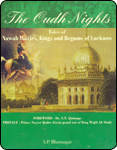The Oudh Nights
About Book

This book is for those readers who want to know the truth about Oudh and the past of Nawabi Lucknow. In the eyes of East India Company, the Nawab Wazirs, Kings and Begums of Lucknow were much maligned persons in the history of Oudh. Of all the persons the last deposed King Wajid Ali Shah was charged with infamy. Not many Indians are aware that interested parties to dethrone him, spread canards judiciously. Few of the younger generation of India care to remember the heroic effort of Begum Hazrat Mahal who led from the front and fought to liberate the country from the British. She refused to accept not once but many times, offers of security and due privileges from the East India Company. She wanted to live with independence, dignity and honor and not on crumbs thrown by a foreign power. She died unsung in Kathmandu, Nepal. Her equally brave son Birjis Qadr spent his precious childhood and youth in fighting against the British and then died under mysterious circumstances when he returned to Calcutta.
The Naishapur dynasty of Oudh founded by Mohammed Ameen Saadat Khan Burhan-ul-Mulk, produced men like Safdar Jung who brought Oudh to the forefront of Hindoostan, Shuja-ud-Daulah and Asaf-ud-Daulah sprinkled rainbow of colors in the skylines of the cities they resided, Saadat Khan brought prosperity, Ghazi-ud-Din Haider and Nasir-ud-Din Haider assimilated Western thoughts, Mohammad Ali Shah and Amjad Ali Shah added some cosmetic touch to the city, and Wajid li Shah introduced the culture of mass entertainment and a drive for everything Swadeshi. The last King Birjis Qadr and Queen Mother Begum Hazrat Mahal infused the spirit of patriotism and sacrifice of life for the motherland in every living person of Oudh. The ruling dynasty founded by a Persian, continued in Oudh for more than 100 years. Lucknowites still gratefully acknowledge the contributions of these Nawab Wazirs, Kings and Begums who gave them a distinct Oudh culture, which represented the synthesis of two great civilizations of Hindoostan and Persia. This fusion led to what is called Ganga-Jamuna culture. It was rightly named so because it had roots deep down in the sweet smelling soils of Oudh. The last reigning monarch of the dynasty, Wajid Ali Shah was a true representative of Oudh, who was born, brought up in Oudh and identified himself completely as any Oudhi Person. These unique cultural syntheses led to many Muslims as ardent devotees of Lord Ram and Lord Krishna. The British replaced the Naisapur dynasty. It was not by people's choice but by the old maixm, might is right.
Some new found facts about Birjis Qadr and his descendants are included. Some special photo features in the book are: Begum Hazrat Mahal's grave in Kathmandu, Nepal, Wajid Ali Shah's grave and Mausoleum in Calcutta, copy of Wajid Ali Shah's own hand written Quraan, Birjis Qadr with his son and attendants after his return from Nepal and a painting of Begum Hazrat Mahal leading the attack" in AlamBagh engagement against the British.
About The Author
Born in 1934, at the holy city of Prayagraj (Allahabad), the author feels pride in saying, "the city that has given five Prime Ministers to the country". He completed his Bachelors education from University of Allahabad and then obtained his post Graduate degree in engineering from University of Massachusetts, USA, Literary environment of Allahabad had a lasting influence through out his life.
An eminent engineer of international standing having served in a World Bank Project in Malaysia and led a United Nations F.A.O. Project Team in Nigeria, he retired from Punjab Agricultural University in 1994 where he served for 28 years as a Professor, Head of the Department, Dean of the Engg. College and Director of School of Energy, There after followed a two years stint of heading nationally renowned Sardar Patel Renewable Energy Institute located in Vallabh Vidyanagar, Gujarat. He is recipient of several national level awards including the highest research award in Agricultural Engineering from Indian Council of Agricultural Research. He is a Fellow of Institution of Engineers India, Indian Society of Agricultural Engineers and the Asian Society of Agricultural Engineering and several other National Societies. He is author of two books, wrote chapters in two books, served as Chief Editor of Journal of Agricultural Engineering, member of editorial boards of National and International Journals and author of several technical reports and papers. He has been Chairman and member of several National Committees. He represented India in many International meetings. Besides contributions in his own engineering area, he has written one Hindi Drama that was stage played in Banda and other cities of U.P He wrote several short stories in Hindi based on historical background.
History always fascinated him. "I would have opted a career in History and in Films as Director and Producer of Historical Films in the mould of Late Sohrab Modi - "thus expressed the author when questioned further. Mughals held a special place for him. His first book on history related subject, titled "Delhi and its Fort Palace - A Historical Preview" unfolds the stories of 14 cities starting from Indraprastha of Mahabharat times that now constitute the modern city of New Delhi. Of all. cities, Imperial city of Mughals, Shahjahanabad and Red Fort find a special mention. The book was well received with in the country and abroad.
His second book titled "The Oudh Nights-Tales of Nawab, Wazirs, Kings and Begums of Lucknow" is now before the Readers.
ISBN : 81-8290-064-6
Price: ![]() 2500/-
2500/-
Publisher : Vedams Books

